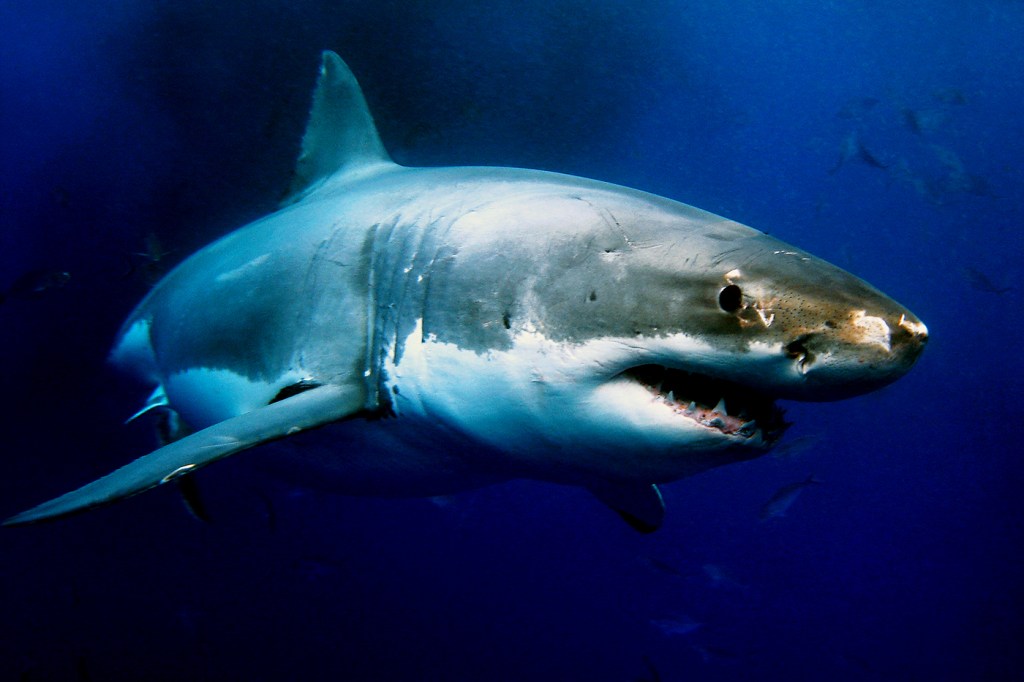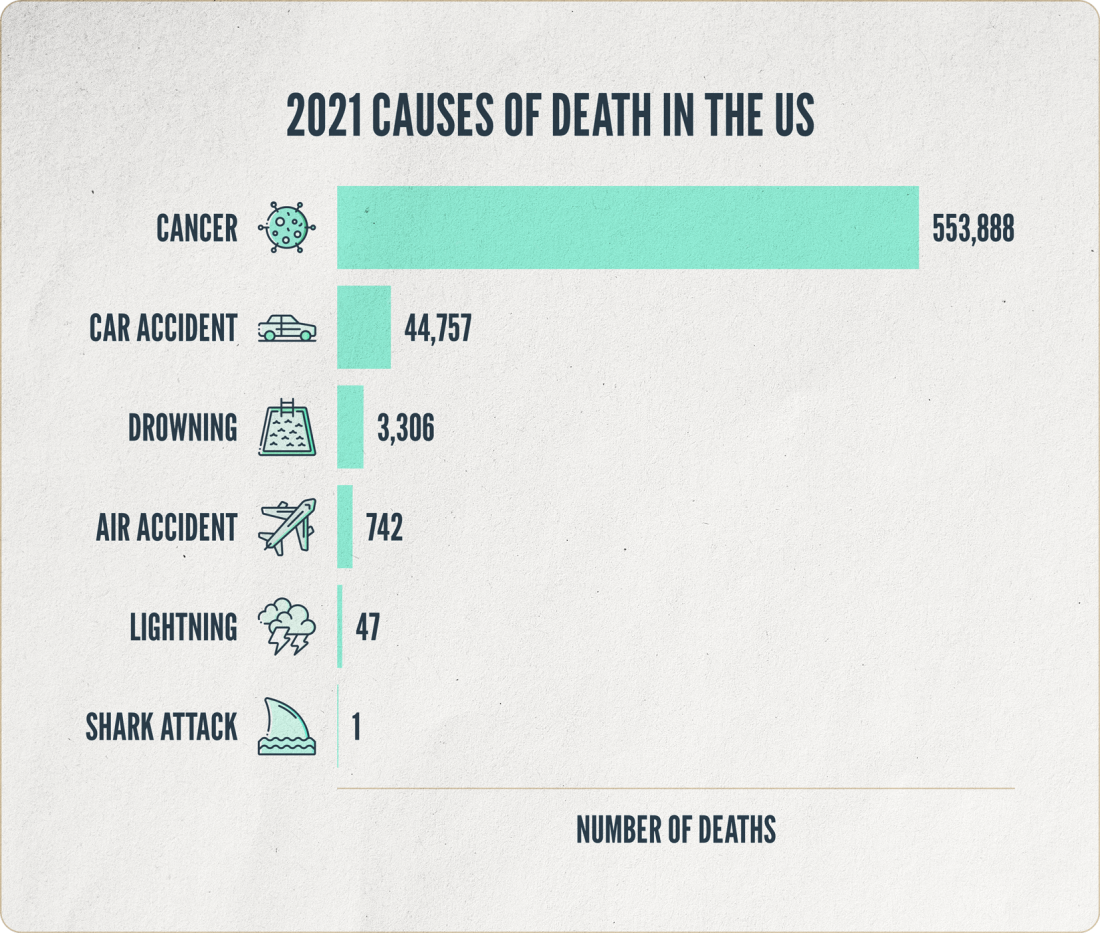It’s Shark Week, so you may ask, ‘How likely am I to get attacked by a shark?’

The Discovery Channel’s now iconic “Shark Week” is upon us, and so is the perception that sharks are responsible for a lot more carnage than statistics bear out.
Susan Mello, associate professor of communications studies at Northeastern University, calls it the “Jaws Effect.”
Media depictions of sharks focus on their potential lethality when shark fatalities in the U.S. are incredibly rare, Mello says.
The University of Florida, which maintains an International Shark Attack File, says that in 2022, five people were killed in unprovoked shark attacks worldwide, including one fatality in the U.S., a figure that pales in comparison to 19 U.S. deaths by lightning strike reported by the National Weather Service.

Sources: All accidental death information from National Safety Council. Disease death information from Centers for Disease Control and Prevention. Shark fatality data provided by the International Shark Attack File.
Lifetime risk is calculated by dividing the 2021 population (331,893,745) by the number of deaths, divided by 76.6, the life expectancy of a person born in 2021.
The number of worldwide shark fatalities actually represented a decline from nine in 2021 and 10 in 2020, according to the ISAF.
Unprovoked bites also declined to 57 in 2022, most of which occurred in the U.S. and Australia, from the average 74 unprovoked bites a year since 2013.
The ISAF also reported 32 provoked shark bites last year. Provoked bites are considered those that occur while unhooking a shark from a line, feeding or trying to touch a shark and spear fishing.
Despite these statistics, sharks’ image as a fearsome, stealthy predator persists in the collective imagination and is reflected in heart-pounding titles of this year’s Shark Week lineup, such as “Serial Killer: Red Sea Attacks” and “Jaws in the Shallows.”
A 2021 content analysis of more than 250 episodes of Discovery Channel’s Shark Week—which this year begins Sunday, July 23—found many shows were framed around fear, risk and adrenaline, although 53% also included conservation messages, Mello says.
“Unfortunately in this situation, the media is at fault,” she says.
Sharks continue to make headlines this summer, with reports of at least four people bitten off Long Island in New York in two days around the Fourth of July holiday, none of them fatally.
Scientists are ascribing the attacks in New York this summer and last to a rebound in the population of sand tiger sharks, a species not associated with fatal bites.
But great white sharks—the species featured in the classic movie “Jaws”—are more than capable of killing humans, even though they seldom do.
Their numbers have exploded on the eastern shores of Cape Cod, Massachusetts, raising concerns among swimmers and surfers.
A recent study shows that 800 of the massive fish cruised Cape shorelines from June to October 2015 to 2018. Outside magazine says the numbers indicate the area is now the world’s biggest seasonal gathering spots for great whites.
The sharks have have been responsible for two non-fatal attacks on swimmers off Cape Cod beaches in recent years.
In 2018, an encounters turned lethal with the death of 26-year-old Arthur Medici, who suffered a catastrophic bite by a great white as he boogie boarded off Wellfleet.
Shark expert Greg Skomal of the Massachusetts Division of Marine Fisheries says great whites are on the trail of a seal population that rebounded in the decades following the Marine Animals Protection Act of 1972.
“They are hunting on the Outer Cape, close to shore,” Skomal says.
The presence of the apex predators has resulted in humans changing their behaviors to avoid possible encounters.
The Swim for Life charity event in Provincetown, Massachusetts, that draws hundreds of participants will, for the third September in a row, take place in shallow waters of the East End shoreline rather than the traditional deep water route across Provincetown Harbor due to concerns about sharks, whose local population peaks in late summer and early autumn.
And at ocean-facing beaches from Chatham to Provincetown, lifeguards keep beachgoers close to shore, especially during high tide when sharks ride the swells parallel to the beach in the hunt for seals.
“If they go waist deep or any further, lifeguards will call them back,” says Leslie Reynolds, deputy superintendent of the Cape Cod National Seashore.
She says it used to be that lifeguards had to blow their whistles multiple times a day to get bathers closer to shore due to rip tides or big currents.
But now lifeguards report it’s a rare occasion when they have to wave people in, Reynolds says.
“Behavior has changed. People have learned. Without a doubt, people are staying closer to shore,” she says.
People’s reluctance to go deep may also have something to do with the purple shark flags and giant billboards signaling the presence of great whites that greet beachgoers, messaging tips imported from South Africa and Australia, among other places with a large shark presence.
It’s all part of an education program called Shark Smart.
“A handful of years ago, after we talked to South Africa, we saw they were using shark flags,” Reynolds says.
“You go to any beach, and it will be up. Whether you see the shark or not there are sharks present, and you have to adjust your behavior when you are recreating in the water.”
Also popular with the public is the Sharktivity app operated by the Atlantic White Shark Conservancy, which shows users the locations of white shark sightings.
The Sharktivity app has registered six great white sightings off Cape Cod from July 18 to 20, including two named sharks, Wannabe and Granese.
Mello says the Cape’s Shark Smart program is a good example of risk management communication.
The use of bullet points on the Cape Cod National Seashore website and the flying of the purple shark flag are ways to get complex information to the public in an easily digestible format, she says.
“When you’re in a situation where there’s elevated fear, it’s really hard to get messages through so people can act on the information. It’s why we teach little kids to ‘stop, drop and roll’” during fire emergencies, Mello says.
“It’s important to distill information on how to reduce risk into its simplest form when fear is elevated.”
The Cape Cod National Seashore also provides information about other risks such as the strong currents associated with rip tides, which put the shark danger in context, Mello says.
The University of Florida’s shark attack file also shows multiple comparisons, including the risk of death from alligator attacks and even sand hole collapse.
It turns out that from 1990 to 2006, 16 people in the U.S. died from collapsing sand holes compared to 11 killed in shark attacks.
Think about that the next time you take a shovel to the beach.
Cynthia McCormick Hibbert is a Northeastern Global News reporter. Email her at c.hibbert@northeastern.edu or contact her on Twitter @HibbertCynthia.







